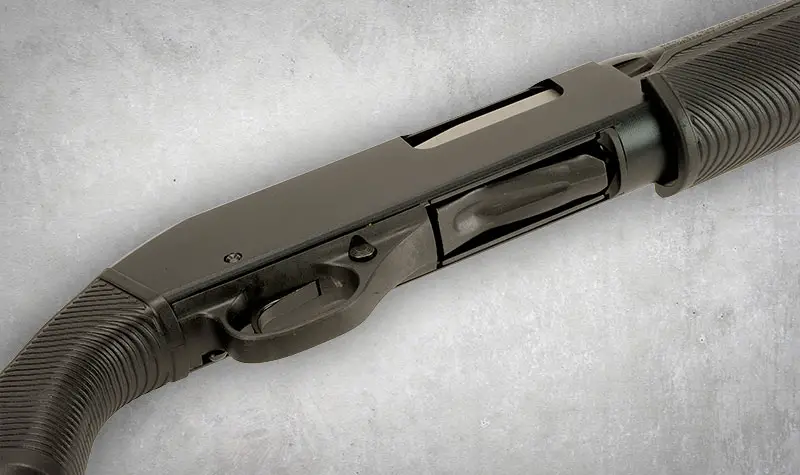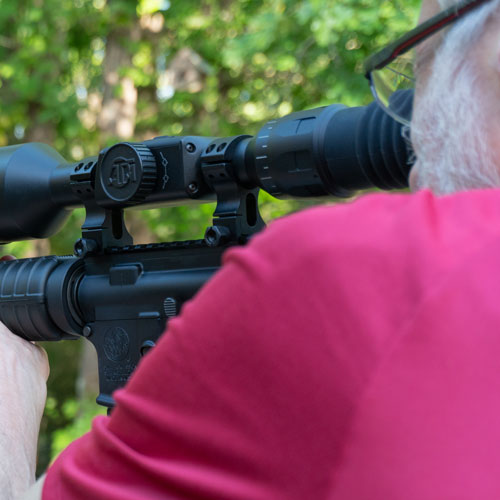The Savage Stevens 320 shotgun is a 12 gauge pump-action shotgun that is enticing due to its lower sticker price, only about $230. This can be tempting for individuals that don’t want to spend a lot of their budget. However it seems that with the lower price point comes a few potential quality control issues.
This isn’t necessarily an indictment on the Stevens 320 as every weapon from any manufacturer has its own little common problems that its users face. Our goal is to ensure everyone has as much information as possible and we can figure out solutions together.

A lot of users love their 320 pump, but we also have a heard a number of concerning problems – from mild irritating malfunction issues to requiring replacement parts to being capable of potentially downright deadly accidental actions.
So let’s dig in…
1: Double Feeding
One large issue with the Savage Stevens 320 shotgun is its tendency to double feed. A double feed is when two rounds are picked up from the magazine and fed into the chamber at the same time. This causes the weapon to be unable to fire as the chamber is jammed.
A double feed requires both observation and time to remedy, and while it can be done quickly with practice, it is still one of the more time-consuming common issues. The Stevens 320 has a frequent issue with double feeding, specifically when the shell lifter tries to feed but immediately gets jammed by the next shell in the magazine. This indicates a flaw in the design of the weapon.
With the Stevens 320, the shell stop and shell interrupter are both attached to the trigger assembly by a single screw. Should the screw loosen, as it will be prone to do with repetitive use of the weapon, then the issue with double feeding will start up. Because this issue is again based on a single screw, double feeding for the Stevens 320 presents a reliably recurring problem. Double feeding ends up stuck in a loop as you tighten, loosen through use, and then have to re-tighten the screw again.

How to Fix
In order to fix the double feed, you have to safely clear the double feed as you would on any other weapon and then remove the trigger assembly to tighten the screw. Again, while in standard practice, clearing a double feed on a weapon can take less time with practice, when it comes to the Stevens 320, clearing the double feed requires the extra step of taking apart the trigger assembly to tighten the faulty screw.
While you can use Loctite to minimize the number of times you would need to tighten the screw, it’s still a consideration if you would need to remove the trigger assembly for any other reason and, more importantly, on the overall effectiveness of the weapon.
2: Ejectors Breaking
The second issue with the Savage Stevens 320 shotgun is its ejector breaking. The ejector is the part of the firearm that ejects the spent casing clear of the weapon. When the ejector breaks, therefore, the shells can no longer be ejected from the shotgun. Clearly, this is a very bad issue to have on any weapon as it can render the firearm effectively useless very quickly.
The Stevens 320 is known to have poor quality ejectors, which can frequently break. When this occurs, it requires the manual extraction of the shell from the shotgun, and then usually, a remediation of a follow-on issue that the extraction failure caused. More than likely, this will be a stovepipe.

How to fix
In particularly bad stovepipe scenarios, the shell will need to be cleared out by shoving a dowel down the muzzle in order to force the jammed casing out of the weapon. This process is definitely time-consuming and not one you want to occur when in a situation where you actually need to use the shotgun.
Being in a situation where you need to rely on the shotgun, only to have it fail to eject, resulting in some intensive and time-consuming action of shoving a dowel down the muzzle, is far from ideal. Even after the muzzle has been cleared of the stovepipe, the shotgun is no longer usable until the ejector has been replaced.
All in all, the hassle of needing to order and then replace the ejector on the shotgun is a large negative mark for the Stevens 320. There are stronger and more durable ejectors designed that are used in other shotgun options.
3: Action Can Open Without Release Being Depressed
Perhaps the most egregious of the three issues of the Savage Stevens 320 being discussed is the ability for the action to open without the release being depressed. Usually, most firearms have some form of a button or mechanism to release the action after it is locked to the rear. With this mechanism, it should not be possible to fire the weapon without that action being released. However, this is not always the case when there is a defect in firearm manufacturing, such as in the case of the Stevens 320.

As such, some Stevens 320 models can be racked without manipulating the action release, causing the firearm to be capable of a malfunction that is called out of battery ignition. Out of battery ignition is when the bolt is not in a normal firing position, in this case, because it did not fully cycle after firing and instead was induced to this position through the manufacturing defect.
If a round is chambered when the shotgun is out-of-battery, then a discharge can occur, causing the weapon to fire unintentionally. Not only is this a safety concern by itself, but because the round was not properly chambered, to begin with, it is possible that the case of the round will fail during this out-of-battery discharge.
If that is the case, then the hot gasses, burning powder, and round fragments will also be thrown from the firearm at high speed. Obviously, this poses a very large danger to both the operator of the firearm as well as any nearby bystanders.
How to fix
If this issue ever occurs with a Stevens 320, immediately discontinue the use of the firearm and contact the manufacturer.
Conclusion
In conclusion, because of these issues, it would be hard to recommend a Savage Stevens 320 to anyone who needed a safe, functional shotgun. This is surprising as Savage is usually known for producing great weapons and we’ve recommended several of their products before.
First, pump-action shotguns have an increased risk of user-induced malfunctions, even with a perfectly fine, well-manufactured shotgun. To combine a pump-action shotgun with a myriad of performance issues, that is asking for problems.
If your heart is set on a pump-action shotgun, then there are plenty of options that do not include the large and dangerous set of problems that the Stevens 320 contains: the design flaw of a single screw attaching the shell stop and shell interrupter, to the high likelihood your ejector will fail or break, to the very dangerous option of accidentally causing an out-of-battery discharge.

George has been an avid shooter for twenty years. He began shooting when he was gifted a Browning SA-22 for target practice. Now, as an academic, he combines his love of firearms and knowledge of history to write for firearms blogs and is still a frequent sight at the local range.

I have a savage 320 20ga I was shooting the other day n my front sight fall off not I can’t us my gun what I need to do here n the sight will not got back in
The action on a 320 pump 20 gauge will not close all the way when pumped. It won’t stay locked. If I loosen the magazine nut which backs the barrel up or take the barrel of it works fine. But that leaves a gap between the barrel and receiver. I looked at the bolt anf it seems warn at the pin. Any help please.